Neminatha
Neminatha is the twenty-second tirthankara (ford-maker) in Jainism. He is also known simply as Nemi, or as Aristanemi which is an epithet of the sun-chariot. Along with Mahavira, Parshvanatha and Rishabhanatha, Neminatha is one of the twenty four tirthankaras who attract the most devotional worship among the Jains.
| Neminatha | |
|---|---|
22nd Jain Tirthankara | |
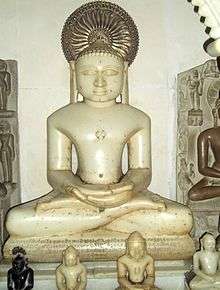 Image of Neminatha at a Jain temple in Bateshwar, Uttar Pradesh | |
| Other names | Arishtanemi |
| Venerated in | Jainism |
| Predecessor | Naminatha |
| Successor | Parshvanatha |
| Symbol | Shankha (conch)[1] |
| Height | 10 bows (98 feet)[2] |
| Age | 1000 years (canonical); 118 years (historical assumption) |
| Color | Black |
| Personal information | |
| Born | |
| Died | Mount Girnar |
| Parents |
|
| Part of a series on |
| Jainism |
|---|
 |
|
Jain prayers |
|
Ethics |
|
Major sects |
|
Texts |
|
Festivals
|
|
|
According to Jain beliefs, Neminatha lived 2356 years before the 23rd tirthankara Parshvanatha. He is mentioned as the youngest son of king Samudravijaya and queen Shivadevi in Jainism. Krishna, the Hindu deity, is mentioned as his cousin. He is believed to have been born at Sauripura (Dvaraka) in the Yadu lineage, like Krishna. His birth date is mentioned as the fifth day of Shravana Shukla of the Hindu calendar. He is believed to have herded cattle and to have become fond of animals. According to Jain belief, on his wedding day Neminatha heard the cries of animals being killed for the marriage feast, and moved by the sorrow he renounced the world to become a monk – a scene found in many Jain artwork. He is believed to have attained moksha on Girnar Hills near Junagadh, a pilgrimage center for Jains.
Nomenclature
The name Neminatha consists of two Sanskrit words, Nemi which means "rim, felly of a wheel" or alternatively "thunderbolt",[3] and natha which means "lord, patron, protector".[4] According to the Jain text Uttarapurana, as well as the explanation of Hemachandra, it was the ancient Indian deity Indra who named the 22nd tirthankara as Neminatha, because he viewed the Jina as the "rim of the wheel of dharma". In Svetambara Jain texts, his name Aristanemi came from a dream his mother during pregnency, where she saw a "wheel of Arista jewels".[5] His full name is mentioned as Aristanemi which is an epithet of the sun-chariot.[6][7] Neminatha's name is spelled close to the 21st tirthankara Naminatha.[8]
Life In Jain tradition
Neminatha was the twenty-second tirthankara (ford-maker) of the avasarpiṇī (present descending cycle of Jain cosmology).[9][10][11] Jain tradition place him as a contemporary of Krishna, the Hindu deity.[12] According to Jain history, there was a gap of 581,750 years between the Neminatha and his predecessor, Naminatha.[13][8] According to Jain beliefs, he lived 2356 years before the 23rd tirthankara, Parshvanatha.[13]
Birth and early life

Neminatha is mentioned as the youngest son of king Samudravijaya and queen Shivadevi of the Yadu lineage,[15] born at Sauripura (Dvaraka).[16] He believed to have become fond of animals in his early life due to being in a cattle herding family. Jain legends place him in the Girnar-Kathiawad (in Saurashtra region of modern-day Gujarat).[17][18][19] His birth date is believed to be the fifth day of Shravana Shukla of the Hindu calendar.[11] He is believed to have been born with a dark-blue skin complexion,[20] very handsome but a shy young man.[15][16] His father is mentioned as the brother of Vasudeva, Krishna's father, therefore the he is mentioned as the cousin of Krishna in Trishashti-salaka-purusha-charitra.[9][21][14][22][23]
In one of the legends, on being taunted by Satyabhama, wife of Krishna, Neminatha is depicted to have blown Panchajanya, the mighty conch of Krishna.[16] According to the texts, no one could lift the conch except Krishna, let alone blow it.[16] After this event, Puranas state that Krishna decided to test Neminatha's strength and challenged him for a friendly duel. Neminatha, being a tirthankara, is believed to have defeated Krishna easily.[24] He is also mentioned as spinning the chakra (discuss, primary weapon of Krishna) on his fingers during his childhood.[16]
As a teacher
In the war between Krishna and Jarasandha, Neminatha is believed to have participated alongside Krishna.[25] He is believed to have taught Krishna the knowledge that he shared with Arjuna in the Bhagavad Gita. This a believed to be the reason that has led Jains to accept, read and cite the same as a spiritually important text. This is believed to be the reason for celebrating Krishna related festivals in Jainism and for intermingle with Hindus as spiritual cousins.[26] Chandogya Upanishad, a religious text in Hinduism, mentions Angiras Ghora as the teacher of Krishna.[12] He is believed to have taught Krishna the five vows, namely, honesty, asceticism, charity, non-violence and truthfulness.[12] Ghora is identified as Neminatha by some of the scholars.[12] Mahabharata mentions him as the teacher of the path of salvation to king Sagara.[12] He may also be identified with a Scandinavian or Chinese deity, but such claims are not accepted generally.[27]
Renunciation and final days
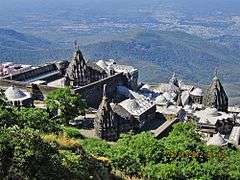
Jain tradition holds that the Neminatha's marriage was arranged with Rajulakumari or Rajimati or Rajamati, daughter of Ugrasena.[16] Ugrasena is believed to be the king of Dvārakā and maternal grandfather of Krishna.[16] He is believed to have heard animal cries as they were being slaughtered for the marriage feast. Taken over by sorrow and distress at the sight, he is believed to have given up the desire of getting married, and to have become a monk and gone to Mount Girnar.[9][28][29][22][8] His bride-to-be is believed to have followed him, becoming a nun and joining his ascetic order.[16][23] According to Kalpasutras, Neminatha led an ascetic life there by eating only once every three days,[30] meditated for 55 days and then obtained omniscience on Mount Raivataka, under a Mahavenu tree.[20] According to Jain texts Neminatha had 11 gandhara with Varadatta Svami as the leader of the Neminatha disciples.[31] Neminatha's sangha (religious order) consisted of 18,000 sadhus (male monks) and 44,000 sadhvis (female monks) as per the mentions in Kalpa Sutra.[32]
After a life of about 1,000 years,[33] he is said to have attained moksha (nirvana) on the fifth peak or tonk (Urjayant Parvat) of Mount Girnar.[23][31][9] Of these 1,000 years, he is believed to have spent 300 years as a bachelor, 54 days as an ascetic monk and 700 years as an omniscient being.[30]
Legacy
Worship
Along with Mahavira, Parshvanatha and Rishabhanatha, Neminatha is one of the twenty four tirthankaras who attract the most devotional worship among the Jains.[34] Unlike the last two tirthankaras, historians consider Neminatha and all other tirthankaras to be legendary characters.[9] Scenes from Neminatha's life are popular in Jain art.[31] The yaksha and yakshi of Neminatha are Sarvanha and Ambika according to Digambara tradition and Gomedha and Ambika according to Śvētāmbara tradition.[31]
Literature
_Wellcome_L0034141.jpg)
The Jain traditions about Neminatha is incorporated in the Harivamsa Purana of Jinasena.[35][36] A palm leaf manuscript on the life of Neminatha, named Neminatha-Charitra, was written in 1198-1142 AD. It is now preserved in Shantinatha Bhandara, Khambhat.[37] Rajul's love for Neminatha is described in the Rajal-Barahmasa (an early 14th-century poem of Vijayachandrasuri).[38] The incident were Neminatha is depicted as blowing Krishna's mighty counch is given in Kalpa Sūtra.[6] The separation of Rajul and Neminatha has been a popular theme among Jain poets who composed Gujarati fagus, a poetry genre. Some examples are Neminatha Fagu (1344) by Rajshekhar, Neminatha Fagu (1375) by Jayashekhar and Rangasagara Neminatha Fagu (1400) by Somsundar. A poem Neminatha Chatushpadika (1269) by Vinaychandra depicted the same story.[39][40][41][42][43] Hindu tradition mentions about Neminatha in vedas like Rigveda, Yajurveda and Samaveda.[12]
Iconography
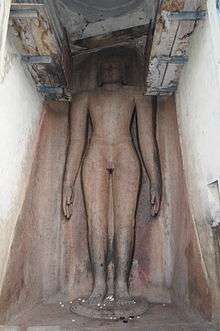
Neminatha is believed to have had the same dark-bluish colored skin as Krishna.[44] Painting depicting his life stories generally identify him as dark colored. His iconographic identifier is a conch carved or stamped below his statues. Sometimes, as with Vishnu's iconography, a chakra is also shown near him, as in the 6th-century sculpture found at the archaeological site near Padhavali (Madhya Pradesh).[45] Artworks showing Neminatha sometimes include Ambika yakshi, but her color varies from golden to greenish to dark-blue, by region.[46] The earliest known image of Neminatha was found in Kankali Tila dating back to c. 18 CE.[47]
.jpg) Neminatha, Nasik Caves, 6th century
Neminatha, Nasik Caves, 6th century Akota Bronzes, MET museum, 7th century
Akota Bronzes, MET museum, 7th century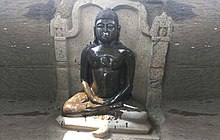
 Neminath Sculpture, National Museum, New Delhi, 11th Century
Neminath Sculpture, National Museum, New Delhi, 11th Century- Image at Maharaja Chhatrasal Museum, 12th century
 Neminath idol, Government Museum, Mathura, 12th Century
Neminath idol, Government Museum, Mathura, 12th Century Depiction of Neminatha on Naag as bed, chakra on foot finger and conch played by nose at Parshvanath temple, Tijara
Depiction of Neminatha on Naag as bed, chakra on foot finger and conch played by nose at Parshvanath temple, Tijara
Temples
- Girnar Jain temples
- Tirumalai (Jain complex)
- Kulpakji
- Arahanthgiri Jain Math
- Nemgiri
- Dilwara Temples
- Bhand Dewal, Arang
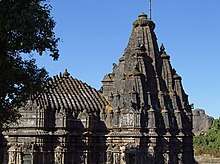 Girnar Jain Temple
Girnar Jain Temple

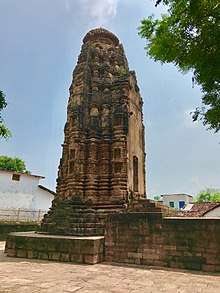 Bhand Dewal
Bhand Dewal.jpg)
References
Citations
- Tandon 2002, p. 45.
- Sarasvati 1970, p. 444.
- Monier Williams, p. 569.
- Monier Williams, p. 534.
- Umakant P. Shah 1987, pp. 164-165.
- Jain & Fischer 1978, p. 17.
- Zimmer 1953, p. 225.
- von Glasenapp 1925, pp. 317-318.
- "Arishtanemi: Jaina saint". Encyclopedia Britannica. Retrieved 15 September 2017.
- Zimmer 1953, p. 224.
- Tukol 1980, p. 31.
- Natubhai Shah 2004, p. 23.
- Zimmer 1953, p. 226.
- Jain & Fischer 1978, pp. 16–17.
- Doniger 1993, p. 225.
- Natubhai Shah 2004, p. 24.
- Dhere 2011, pp. 193–196.
- Upinder Singh 2008, p. 313.
- Cort 2001, p. 23.
- Umakant P. Shah 1987, p. 164.
- Johnson 1931, pp. 1–266.
- Umakant P. Shah 1987, pp. 165-166.
- Sangave 2001, p. 104.
- Doniger 1993, p. 226.
- Beck 2012, p. 156.
- Long 2009, p. 42.
- Natubhai Shah 2004, pp. 23-24.
- Sehdev Kumar 2001, pp. 143–145.
- Kailash Chand Jain 1991, p. 7.
- Jones & Ryan 2006, p. 311.
- Umakant P. Shah 1987, p. 165.
- Cort 2001, p. 47.
- Melton & Baumann 2010, p. 1551.
- Dundas 2002, p. 40.
- Umakant P. Shah 1987, p. 239.
- Upinder Singh 2016, p. 26.
- Umakant P. Shah 1987, p. 253.
- Kelting 2009, p. 117.
- Amaresh Datta 1988, p. 1258.
- K. K. Shastree 2002, pp. 56–57.
- Nagendra 1988, pp. 282–283.
- Jhaveri 1978, pp. 14, 242–243.
- Parul Shah 1983, pp. 134-156.
- Umakant P. Shah 1987, pp. 164-168.
- Umakant P. Shah 1987, pp. 164-170.
- Umakant P. Shah 1987, pp. 264-265.
- Umakant P. Shah 1987, p. 166.
Sources
- Beck, Guy L. (1 February 2012), Alternative Krishnas: Regional and Vernacular Variations on a Hindu Deity, SUNY Press, ISBN 0-7914-6415-6
- Cort, John E. (2001), Jains in the World: Religious Values and Ideology in India, Oxford University Press, ISBN 978-0-19-803037-9
- Datta, Amaresh (1988), Encyclopaedia of Indian Literature, Sahitya Akademi, ISBN 978-81-260-1194-0
- Dhere, Ramchandra C (2011), Rise of a Folk God: Vitthal of Pandharpur, Oxford University Press, ISBN 978-0-19-977759-4
- Dundas, Paul (2002) [1992], The Jains (Second ed.), Routledge, ISBN 0-415-26605-X
- Doniger, Wendy (1993), Purana Perennis: Reciprocity and Transformation in Hindu and Jaina Texts, SUNY Press, ISBN 0-7914-1381-0
- Jain, Jyotindra; Fischer, Eberhard (1978), Jaina Iconography, 12, Brill Publishers, ISBN 978-90-04-05259-8
- Jain, Kailash Chand (1991), Lord Mahāvīra and His Times, Motilal Banarsidass, ISBN 978-81-208-0805-8
- Jhaveri, Mansukhlal (1978), History of Gujarati Literature, Sahitya Akademi, archived from the original on 20 December 2016
- Johnson, Helen M. (1931), Neminathacaritra (Book 8 of the Trishashti Shalaka Purusha Caritra), Baroda Oriental Institute
- Jones, Constance; Ryan, James D. (2006), Encyclopedia of Hinduism, Infobase Publishing, ISBN 978-0-8160-7564-5
- Kelting, M. Whitney (2009), Heroic Wives Rituals, Stories and the Virtues of Jain Wifehood, Oxford University Press, ISBN 978-0-19-538964-7
- Kumar, Sehdev (2001), A Thousand Petalled Lotus: Jain Temples of Rajasthan : Architecture & Iconography, Abhinav Publications, ISBN 978-81-7017-348-9
- Long, Jeffery D. (2009), Jainism: An Introduction, I. B. Tauris, ISBN 978-1-84511-625-5
- Melton, J. Gordon; Baumann, Martin, eds. (2010), Religions of the World: A Comprehensive Encyclopedia of Beliefs and Practices, One: A-B (Second ed.), ABC-CLIO, ISBN 978-1-59884-204-3
- Nagendra (1988), Indian Literature, Prabhat Prakashan
- Sangave, Vilas Adinath (2001), Facets of Jainology: Selected Research Papers on Jain Society, Religion, and Culture, Mumbai: Popular Prakashan, ISBN 978-81-7154-839-2
- Sarasvati, Swami Dayananda (1970), An English translation of the Satyarth Prakash, Swami Dayananda Sarasvati
- Shah, Natubhai (2004), Jainism: The World of Conquerors, 1, Motilal Banarsidass, ISBN 9788120819382
- Shah, Parul (31 August 1983), "5", The rasa dance of Gujarata (Ph.D.), 1, Department of Dance, Maharaja Sayajirao University of Baroda, hdl:10603/59446
- Shastree, K. K. (2002), Gujarat Darsana: The Literary History, Darshan Trust, Ahmedabad
- Singh, Upinder (2016), A History of Ancient and Early Medieval India: From the Stone Age to the 12th Century, Pearson Education, ISBN 978-93-325-6996-6
- Shah, Umakant Premanand (1987), Jaina-rūpa-maṇḍana: Jaina iconography, Abhinav Publications, ISBN 81-7017-208-X
- Singh, Upinder (2008), A history of ancient and early medieval India : from the Stone Age to the 12th century, New Delhi: Pearson Education, ISBN 978-81-317-1120-0
- Tandon, Om Prakash (2002) [1968], Jaina Shrines in India (1 ed.), New Delhi: Publications Division, Ministry of Information and Broadcasting, Government of India, ISBN 81-230-1013-3
- Tukol, T. K. (1980), Compendium of Jainism, Dharwad: University of Karnataka
- von Glasenapp, Helmuth (1925), Jainism: An Indian Religion of Salvation [Der Jainismus: Eine Indische Erlosungsreligion], Shridhar B. Shrotri (trans.), Motilal Banarsidass (Reprint: 1999), ISBN 81-208-1376-6
- Williams, Monier, Nemi - Sanskrit English Dictionary with Etymology, Oxford University Press
- Zimmer, Heinrich (1953) [April 1952], Campbell, Joseph (ed.), Philosophies Of India, London, E.C. 4: Routledge & Kegan Paul Ltd, ISBN 978-81-208-0739-6,
CS1 maint: location (link)